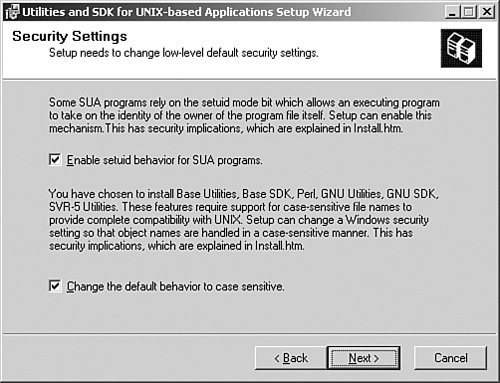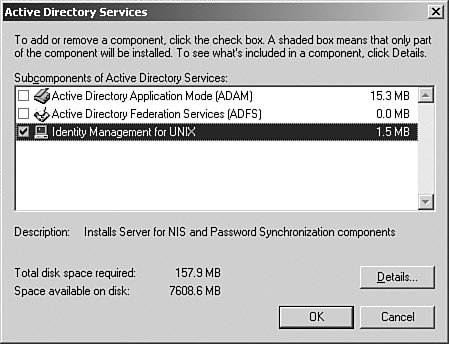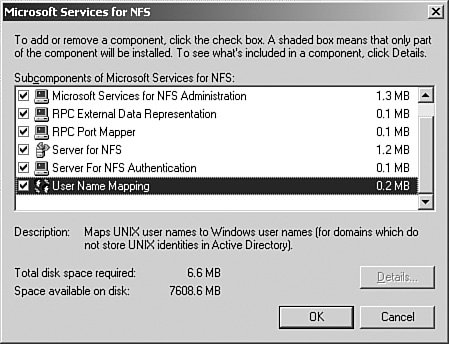Understanding and Using Services for Unix 3.5
| Microsoft has a long history of not "playing well" with other technologies. With Windows 2003, Microsoft introduced Services for Unix 3.5. With the dawn of Windows Server 2003 R2, Services for Unix (SFU) becomes core to the operating system, showing Microsoft's commitment to interoperability. SFU is now available on the installation CD instead of as a downloadable feature pack, and its integration with Server 2003 R2 is seamless for the first time. For many years, Unix and Windows systems were viewed as separate, incompatible environments that were physically, technically, and ideologically different. Over the years, however, organizations found that supporting two completely separate topologies within their environments was inefficient and expensive; a great deal of redundant work was also required to maintain multiple sets of user accounts, passwords, environments, and so on. Slowly, the means to interoperate between these environments was developed. At first, most of the interoperability tools were written to join Unix with Windows, as evidenced by Samba, a method allowing Linux/Unix platforms to access Windows NT file shares. Microsoft's tools always seemed a step behind those available elsewhere. With the release of the new Services for Unix tools in Server 2003 R2 Microsoft leapfrogs traditional solutions, such as Samba, and becomes the leader for cross-platform integration. Long-awaited functionality such as password synchronization, the capability to run Unix scripts on Windows, joint security credentials, and the like were presented as viable options and can be now be considered as part of a migration to or interoperability scenario with Windows Server 2003. The Development of Services for UnixServices for Unix has made large strides in its development. From initial skepticism, the product has developed into a formidable integration and migration utility that allows for a great deal of inter-environment flexibility. The first versions of the software, 1.x and 2.x, were limited in many ways, however. Subsequent updates to the software vastly improved its capabilities and further integrated it with the core operating system. A watershed development in the development of Services for Unix was the introduction of the 3.0 version of the software. This version enhanced support for Unix through the addition or enhancement of nearly all components. Included with version 3.0 was the Interix product as well, an extension to the POSIX infrastructure of Windows to support Unix scripting and applications natively on a Windows Server. Then, version 3.5 of SFU WCS released, which included several functionality improvements over SFU 3.0. The following components and improvements have been made in the 3.5 release:
Finally, we come to the Server 2003 R2integrated version of SFU. Besides being slip-streamed directly into the operating system, some functional changes have been made. Most importantly, the structure of SFU has changed considerably. Here is the structure of major improvements for the R2 SFU offering:
The Components of Services for UnixServices for Unix is composed of several key components, each of which provides a specific integration task with different Unix environments. Any or all of these components can be used as part of Services for Unix as the installation of the suite can be customized, depending on an organization's needs. The major components of SFU are as follows:
Each component can be installed separately or multiple components can be installed on a single server as necessary. All components are available from the Add/Remove Window Components Wizard in the Control Panel. Each component is described in more detail in the following sections. Prerequisites for Services for UnixServices for Unix R2 interoperates with various flavors of Unix, but was tested and specifically written for use with the following Unix iterations:
Note SFU is not limited to these versions of Sun Solaris, Red Hat Linux, HP-UX, IBM AIX, and Mac OS X. It actually performs quite well in various other similar versions and implementations of Unix and Linux. Services for Unix has some other important prerequisites and limitations that must be taken into account before considering it for use in an environment. These factors include the following:
Installing Services for Unix R2The installation of Services for Unix for Windows Server 2003 R2 is as simple as adding another Windows component. From the Control Panel, go to Add/Remove programs, and then Add/Remove Windows Components. The various parts that make up SFU are all available in their appropriate areas. Note You will need your Windows 2003 R2 installation CD to add each of the Services for Unix components. The installation of Services for Unix is straightforward and uses the familiar Microsoft Add/Remove Windows Components Installation Wizard. After the prerequisites have been satisfied and the desired functionality has been identified. To install SFU R2, perform the following steps:
Figure 8.1. Download the Utilities and SDK for Unix-based Applications. Figure 8.2. Reviewing the Utilities and SDK for Unix-based Applications options. Figure 8.3. Active Directory Services details. Figure 8.4. Microsoft Services for NFS options. Note The Utilities and SDK for Unix-based Applications is fairly large, approximately 180MB. You may download this package in advance to speed up the installation process. There are different packages for x86 and AMD architectures. Once installed, the various functionalities can be tested in a lab environment or deployed into production. |
EAN: 2147483647
Pages: 499


